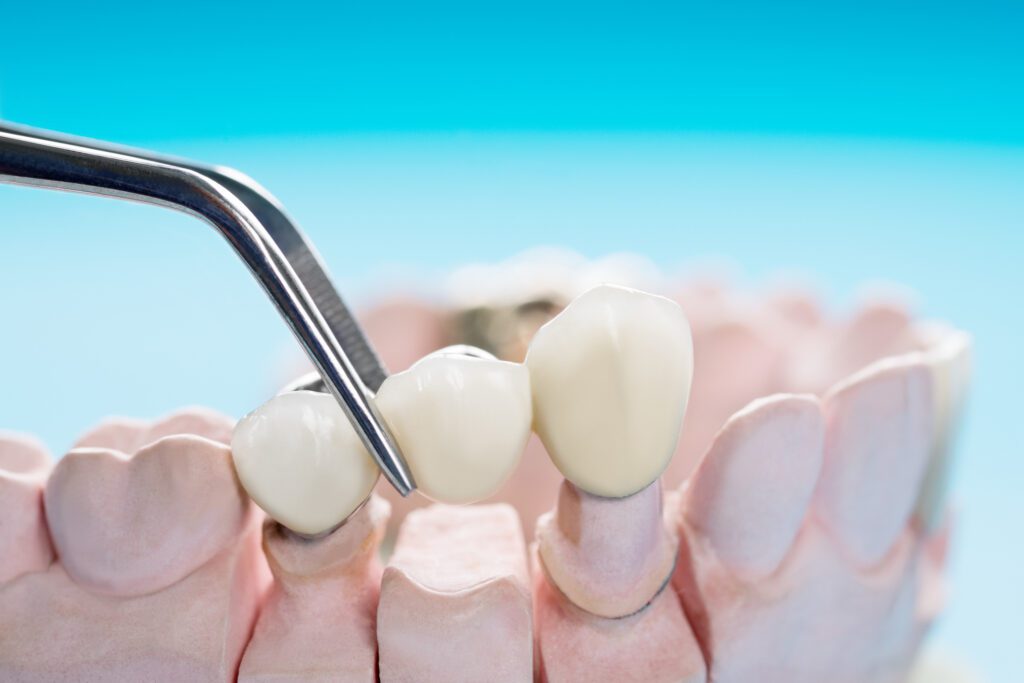We can place a dental bridge in your mouth to “bridge” the gap left by a single tooth or several missing teeth. It restores your appearance and prevents your remaining teeth from drifting out of place. Dental bridge treatment in our Garland, TX office can restore the look and function of your teeth. Tooth bridges are restorative dentistry treatments that can renew the form and function of missing teeth.
A bridge typically uses abutments and pontics. The abutments act as support for the pontics, or false teeth. Two dental crowns at either end of the dental bridge will use your natural teeth as anchors so the restoration stays firmly in place. The number of prosthetic teeth you need depends on the extent of your tooth loss. We may also recommend using implants instead of natural teeth to support your bridge.

Why You Should Replace Missing Teeth
Losing one or more permanent teeth can make a big difference in your confidence and oral health. Waiting to replace missing teeth can result in these problems:
- Jaw bone loss
- Facial sagging
- Dental drift
- Trouble biting and chewing
- Further tooth loss
- Tooth decay
- Gum disease
Replacing missing teeth with a professionally made restoration can prevent these problems. Contact our office if you have noticed issues due to your lost teeth. We will examine your smile to find the best option for you.
Types of Dental Bridges
We will help you determine which bridge is right for your number of missing teeth, budget, and health concerns. There are many types of dental bridges to choose from, including:
- Traditional Bridge: The most common type of bridge is traditional. It uses support from natural teeth on either side of a missing tooth gap. The natural teeth need crowns to keep the bridge stable.
- Cantilever Bridge: Unlike a traditional bridge, a Cantilever bridge uses support from only one side of the missing tooth gap. The downside to this bridge is its increased risk of cracking or breaking in the front of the mouth. This bridge is more prone to damage because it only has support from one side.
- Maryland Bridge: Also known as a resin-bonded bridge, a Maryland bridge is a false tooth that uses metal wings bonded to natural teeth. They benefit patients with missing teeth due to genetics or dental trauma. Maryland bridges are best for single missing teeth and may not last as long as other types.
- Implant-Supported Bridge: Dental implants are titanium posts that can replace the need for natural teeth for support. Instead of natural teeth, implants support bridges by replacing teeth at the root.
Our office uses traditional and implant bridges because they are the longest-lasting options for replacing one or more lost teeth. Compared to other bridges, traditional and implant-supported options offer more benefits for your future oral health.
Traditional vs. Implant Bridges
Traditional bridges are great for patients who want to replace one or more consecutive missing teeth. We recommend dental bridges if you have missing teeth and healthy enough natural teeth to support crowns. Because they fill the gap left by missing teeth, they prevent shifting teeth and overcrowding. Traditional bridges also cost less than dental implants and do not need lengthy treatment.
For patients who want a longer-lasting restoration, we recommend a bridge supported by implants. In some cases, we may only need one dental implant. Our office also recommends implants to preserve natural, healthy teeth. Traditional bridges use crown-capped teeth for support. However, preparing teeth for dental crowns is unneeded if you receive dental implants.
Dental implants may cost more than traditional bridges but offer permanent results. Once implant posts fuse with the jaw bone, they stay in place like natural tooth roots. We do not need to prepare healthy teeth to place implants. Dental implants also help support the jaw’s health to prevent problems like facial sagging.
Dental Bridge Treatment in Garland, TX
Before treatment, we will take X-rays to look for dental problems and determine how to place the bridge. We will provide treatment if we find cavities, gum disease, or other dental problems. Dental issues can impact the stability of your new teeth.
Once you are healthy enough, we will begin treatment. To secure a traditional bridge, we must prepare teeth on either side of the tooth gap. This preparation removes part of the tooth enamel. While this is harmless if you have decayed or injured teeth, it isn’t needed for healthy teeth.
Then, we will take impressions of your mouth to send to a dental lab. We will place a temporary restoration while the lab creates the final bridge. Once complete, you will return to our office, where we will cement the restoration.
Getting an Implant-Supported Bridge
If you want an implant bridge, we will ensure you have good oral health. Our office may recommend pretreatments, including gum disease treatments, root canals, and tooth extractions. You must also have enough jaw bone if you want dental implants. We can refer you to an oral surgeon for bone grafting treatment. Healthy jaw bone helps the implants fuse in place and become new tooth roots.
Once you are prepared for implant treatment, we will work with a surgeon to place the implant posts. The surgeon will place the posts in the jaw bone and place a healing cap over the posts.
Then, will take dental impressions to send to a lab to create the bridge. Over three to six months, the jaw bone will grow around the implant posts. This process is called osseointegration and ensures your posts become a part of your mouth.
Once your implants heal, the surgeon will place the abutments. These pieces will connect the implants to the final bridge. Once your gums heal, we will place the permanent restoration.
How Much is a Dental Bridge?
The cost of a dental bridge depends on the type you choose and how many teeth need to be replaced. Traditional bridges are typically less expensive than implant-supported bridges. They do not require lengthy treatment or surgery.
While implant bridges cost more upfront, they usually last longer and don’t rely on natural teeth for support. You also don’t need to replace these restorations as often.
Both options can improve your smile and help with chewing, but the right choice depends on your dental health, budget, and long-term goals. Our dentist can explain the options and help you find the best solution to fit your needs. We also offer payment and insurance options to keep you within your budget.
Frequently Asked Questions
How do I clean around and under a dental bridge?
Cleaning under a dental bridge requires special tools like floss threaders or water flossers to reach beneath the pontic (false tooth). Thread a special bridge floss or a threader under the bridge daily to remove trapped food particles and plaque. Small interdental brushes can help clean around the anchor teeth where the bridge connects to your natural teeth.
Consider adding a water flosser to your routine for even better cleaning, as they can flush out debris from areas that are difficult to reach with traditional methods.
Can I get a bridge if I have gum disease or receding gums?
We suggest that patients treat active gum disease before getting a dental bridge. Healthy gums provide crucial support for the anchor teeth that hold your bridge. Receding gums don’t necessarily prevent bridge placement, though. However, they might affect the appearance of your final restoration.
Our office will evaluate the strength of potential anchor teeth and the condition of your gum tissue. In some cases, you might need preliminary treatments like gum grafting or periodontal therapy before proceeding with bridge placement.
Can a dental bridge be placed immediately after an extraction?
Sometimes, yes. Dentists may place a temporary bridge right after extraction while the area heals. A permanent bridge usually comes later, after the gums and bone have settled. It usually takes a few weeks to months after extraction. Immediate placement depends on your specific situation and healing needs.
How long does a dental bridge usually last with good care?
A well-maintained dental bridge typically lasts 10 to 15 years, sometimes even longer. The lifespan depends heavily on good oral hygiene and regular dental visits. Keeping the gums and supporting teeth healthy is key to ensuring your bridge remains strong and functional over time.
Can I eat normally with a dental bridge, or are there dietary restrictions?
You can eat most foods with a dental bridge, though you should avoid extremely sticky or hard foods that might damage it. Initially, start with softer foods while you adjust to the feel of your new bridge. Once you’re comfortable, you can gradually return to your normal diet with a few ongoing precautions.
For long-term success, avoid biting directly into very hard foods, such as nuts or ice, with your bridge. You should also try to distribute chewing forces evenly across both sides of your mouth.
Does insurance cover a dental bridge?
Most dental insurance plans cover bridges at least partially. They usually classify them as major restorative procedures with 50-80% coverage. Coverage depends on your specific plan and whether the bridge is deemed medically necessary rather than purely cosmetic. Some plans impose waiting periods for major work. It’s always a good idea to check with your insurance provider ahead of time.
Call Our Office Today
Do you have one or more missing teeth? Restore your smile with a dental bridge in Garland, TX. Schedule a dental appointment at Cornerstone Family Dentistry to learn more about bridges. You may also call our office for an appointment at 972-271-1302.
Please let us know if you have questions. We’re here to help you get the right treatment for your needs.
